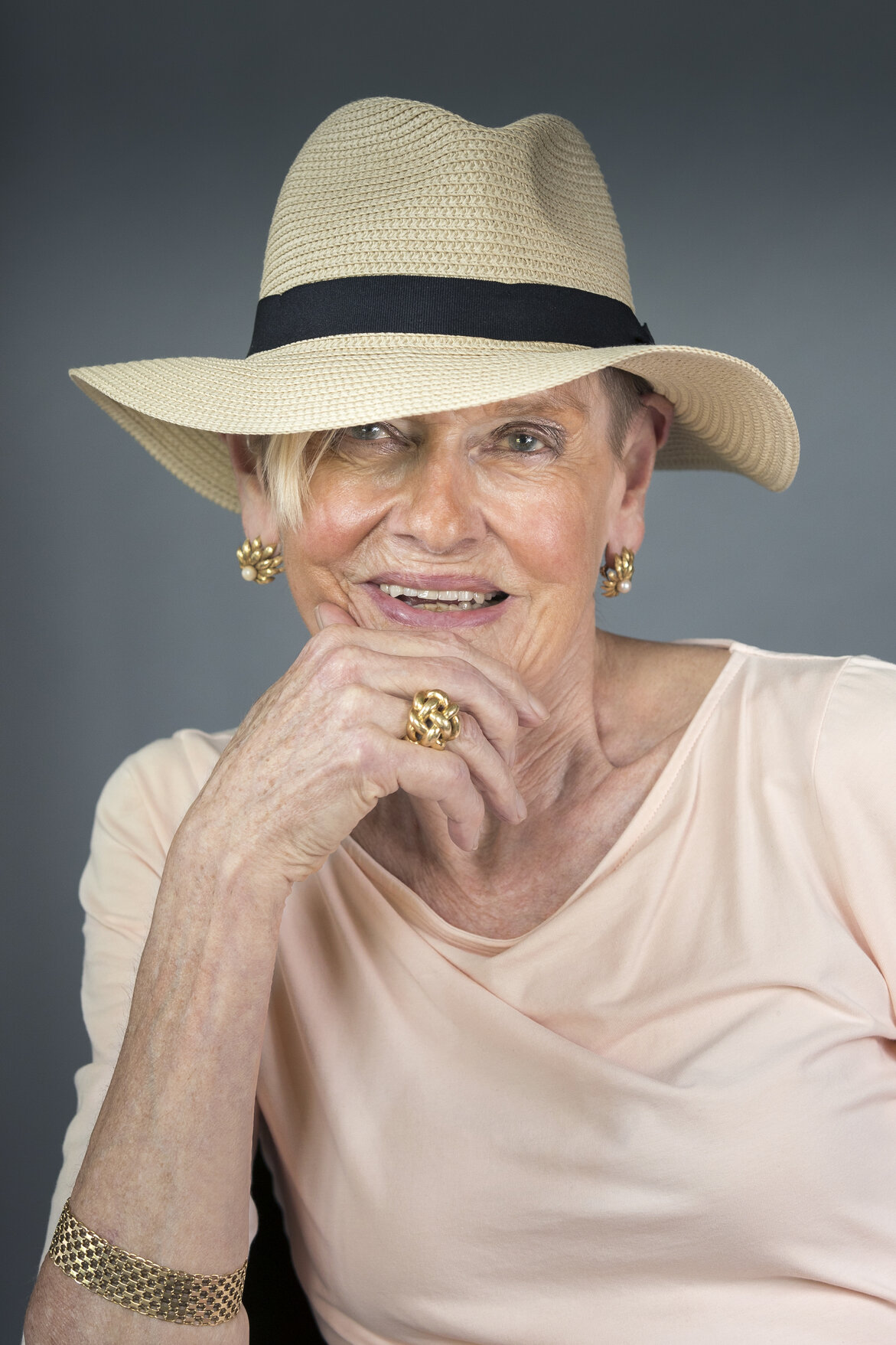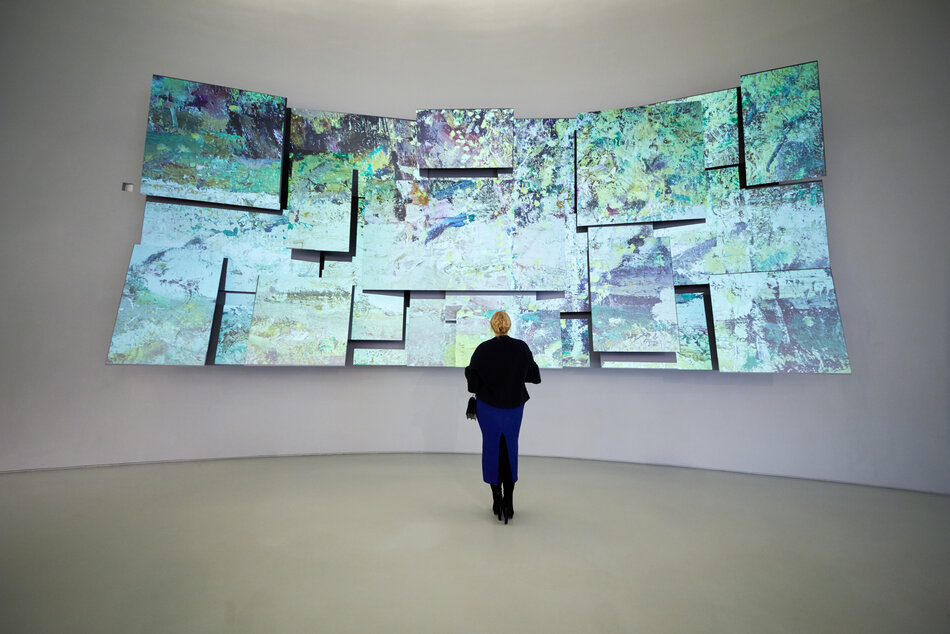Enness Art Advisor and Ambassador, Dr. Stephanie Kim, has curated exhibitions and festivals in 22 cities across the globe and worked with over 500 artists from a range of disciplines. She has recently completed her PhD in Curating Contemporary Art from RCA, and launched an exhibition at SOMA museum in Seoul, the exhibition is on now until 7th of August. See more of Dr. Stephanie Kim work iskaiart.com & Instagram @stephanie_s_kim
***
Future Shock: A Must-see Show!
Strobe lights, smoke, flickering visuals, white noise, and other acoustic and musical elements: as visitors walk into the first room at the Future Shock exhibition, projections on two towering walls dwarf us and bring a sense of stepping into a future landscape. Welcome to Ryoichi Kurokawa's work, presented in the first room at the exhibition, entitled Subassemblies.

Ryoichi Kurokawa, Subassembli. 2022
Audiovisual installation | 2ch H.D. video projection | 4.1ch sound | 16ch strobe light | Duration: 8'00" loop
Weaving 3D scanned images of nature, manufactured buildings and field recordings into computer-generated structures, the exhibit becomes an architectural audio-visual phenomenon: a time sculpture. I first notice a pastoral sequence with almost x-rayed images of trees and rocks superimposed on intersections of windows, doors, and a roof truss - in essence, a ruined building. I am immediately intrigued. I have no context for this work. I collaborated with Ryoichi Kurokawa in 2016 when I premiered his Unfold in Korea as part of an exhibition I was curating. At that time, he used enormous projection screens (4 by 3 metres across) that came from Liverpool and were fashioned onto three tilted projections. About twenty people could lie underneath each screen and gaze at a 10-minute poem.

Ryoichi Kurokawa, Unfold, 2016
Audiovisual installation for Jikji, the Golden Seed, curated by Stephanie S. Kim | 3ch HD video projection | Duration: 10'00" loop
Kurokawa's vision of how stars and star clusters are created brings a new interpretation of how the solar system was born. Kurokawa worked with Astrophysicists at the Research Institute (C.E.A., France) to examine the universe's fundamental laws. It was a unique opportunity to visualize data taken from molecular clouds in space. The exhibit takes data which may hold the secrets behind the birth of stars, presenting the data in an artistic format. The subassemblies from the data included manmade film footage and thermal images. It was intriguing how each source was familiar and unique and came to life as one giant ai-driven image. Those of us in the audience became silhouettes within the massive digital images forming a perfect metaphor: pixels inside data and life within the cosmos.
The exhibition prompted me to find an adequate definition of Future Shock:
Future Shock, as defined by the Cambridge dictionary, is the problem or the uncomfortable feeling that some people experience due to fast changes in technology or society. The term was coined by Alvin Toffler, who authored the book of the same title. Published in 1970, Future Shock sold 6 million copies and has been widely translated and distributed. Fifty years later, the title has the same uncanny urgency. Future Shock is perhaps the fourth or fifth mega-scale 80's studio audio-visual exhibition on Strand – it’s also, perhaps, the best.
I was initially attracted to Future Shock because of the pedigree of the participants and star-studded names associated with the exhibit. However, upon entering, I felt apprehensive and trapped. There were too many intense works assembled within an austere and cold underground building. The setting created a sense of emotional and physical captivity, a kind of synaesthesia brought on by the world the artists depict. This is a world of surveillance, facial recognition, commodification, and commercially driven existence. The title is apt, and I saw it for what it is. I have highlighted some artists and why you maybe already know their work without realizing.
Ryoichi Kurokawa is a self-taught artist and musician, recognizable for his Sonar and other concerts. He began experimenting with synaesthesia in audiovisual installations in the 1990s, overlapping senses of sound, sight and touch in structure and performance. This combination of sensual stimuli is at the heart of most of his works.

The second room by UVA, United Visual Artists, also featured musical collaboration. UVA is well known for the sound-emanating light rods utilized in John Majeski’s Garden (with English hip-hop collective Massive Attack). When UVA presented their solo show at 180 Strand with a row of pendulum lights, the musical score was by Mira Calix, who sadly passed away this year. UVA worked with Massive Attack during their World Tours from 2003 to 2018. They also worked with James Blake's The Colour in Anything tour. This room at Future Shock is best experienced by travelling through it and living with the walls that create a kind of intangible realm that alters your perception of the space you occupy.

The Weirdcore room of the exhibit brings to life an encapsulation of walking into the artist's mind with coloured ribbons and throbbing lights accompanied by a soundtracked by Richard D James aka Aphex Twin.
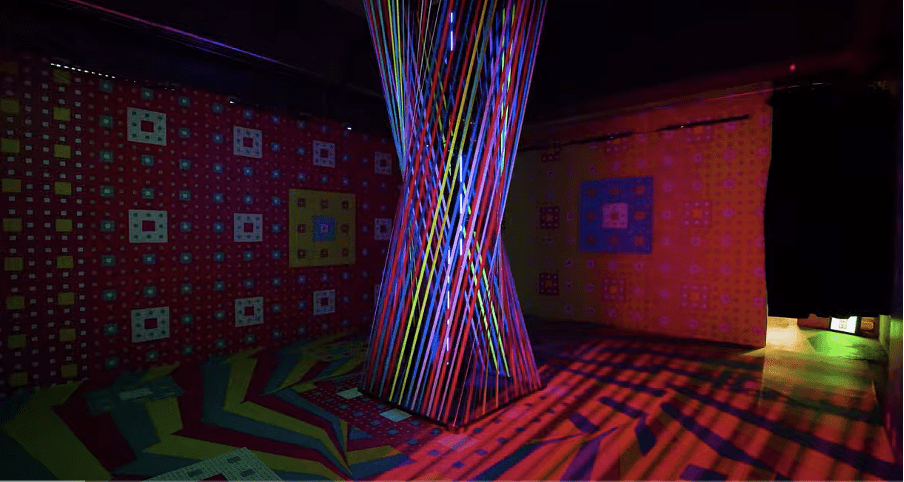
Hamill Industries' installation Floating Points also had an original score accompanied by an electronic musician who studied piano at Chetham's School of Music before receiving a PhD in neuroscience and epigenetics at the University College London.
The L.A.-based studio, Actual Objects, crafted an alternative metaverse populated by digital humans. The interactive installation was overwhelming and almost stressful. This is intended, with Q.R. code entry and infrared face detections.
Gener8ion's Neo Surf was presented as a triptych in the show. Children are depicted in a ruthless yet wasted, gory but beautiful, post-apocalyptic world created by Gener8ion producer, composer Surkin, and director Romain Gavras. It is a familiar evolution of their work "Gosh" for Jamie xx. Gavras also directed Born Free for M.I.A. and No Church in the Wild for Jay-Z and Kanye West. Surkin, AKA Benoit Heitz (born 1985), is a French musician, record producer, D.J. and art director. He first gained attention in 2006 with his work for the French Institutes music label, D.J., and with performances in clubs and appearances at music festivals. He also worked on mixes for artists, including Justice and Chromeo.

Gener8ion's work is a contemporary reinterpretation of Blade Runner, a poetic and dystopian future that in many ways is already here…
One of the most complex, challenging, and sensory exhibits in recent years, Future shock features work by the most accomplished artists, musicians and directors working today. While frequently disturbing and even overwhelming, the exhibit is valuable on many levels: intellectually, emotionally, and physically. For that reason alone, I believe it will have a lasting impact and resonance.
***
Seoul Exhibitions - How to Coexist
Now that travel sanctions and covid restrictions have been lifted, South Korea has become a popular destination for many globe-trotters. Frieze Seoul, K-Pop and interest in Korean films and dramas such as Squid Game are driving many to ask me where to go in Seoul. So I have been suggesting two exhibitions to visit this summer. Both take on how to coexist: Forever Free, addresses our coexistence with animals. The other deals with our relationship with advanced technology such as AI, it is strongly recommended - not just because it is my own curation!
MOM ∞ MAM: Möbius of Body and Mind
This exhibition is held at SOMA Museum, curated by me, is a study of creative and scientific elements of mind and body, and about the relationship between sports and art. Located at the historic Seoul Olympic Park in Seoul, South Korea, SOMA (Seoul Olympic Museum of Art) has been promoting art that examines and celebrates the body as a medium. MOM ∞ MAM goes further by exploring the mind-body connection, stressing how the mind and body are not two separate entities but ever-connected entities, intertwined and endless, like a Möbius strip.
MOM ∞ MAM features 35 works by 17 new and celebrated artists: Marina Abramović, Eugenio Ampudia, Je Baak, Bee Chee Chang, Jia Chang, Paula Garcia, Cole Hanauer, James Harris, Evi Kalogiropoulou, Lee Sang Yong, Lie Sang Bong, MAI (Marina Abramović Institute), Miguel Nunes, Minsu Oh, Ji Hyun Yu, Sadeck Waff, and Moritz Waldemeyer. Standing in sharp contrast to Koh Sang Woo solo exhibition Forever Free, this large group show provides a rich trove of curatorial insights.
My first and most sweeping consideration was to question how sports and art appear as separate fields with few similarities yet share so many close parallels. We must recognize that both artists and athletes constantly challenge the limits of their bodies and minds; that once they reach the top of their field, their achievements become part of the public realm; and that both art and sport face disruption through technology that challenges their core raisons d’être. While this exhibition illustrates the cultural and historical relationship between sports and art from multiple angles, it also attempts to go beyond the dichotomous thinking that separates the body, read as (Mom) in Korean, and the mind, pronounced as (Ma:m). The symbol ‘∞’ symbolises infinity and looks similar to tracks where athletes compete.
While connecting two very different fields, sports and arts, Mom ∞ Mam has looked at different iterations of body and mind in both fields from many angles. The exhibition ventures into the future to examine issues at stake: AI creating artworks, the highly technical development of bodies of professional sportsmen, and today's gamified world. The newly commissioned artworks are exhibited alongside archives and representations from eleven institutions, including some from the National Gallery London, the British Museum, and the Minneapolis Institute of Art.
First Instalment - MOM MOM
Regarding the human body as the home of the sensory system and the interface between an individual and society. Part of the beauty of sport is maximising the use of the human body through training and one’s will. Art embraces the fullness of bodily expression while sport creates extraordinary expressions of the body, and both have influences across cultures and history.
So as we discover exciting intersections between sport and art, we hope to formulate a new interpretation of the two by juxtaposing and assembling them.
Starting with the story of Myron’s Townley Diskobolos (Disk Thrower). Estimated to have been completed in 460–450 BC, it is the symbol of harmony, balance and athletic energy, which has been transformed into a timeless artwork. Phidias’s Zeus of Olympia and the Doryphoros (Spear Bearer) of Polykleitos are other well-known Greek sculptures of classical antiquity. It depicts sturdy, muscular, standing athletes, in Alma-Tadema’s work showing the lasting effect of Greek antiquity even to the 19th century. This continues to the present, as Moritz Waldemeyer creates the Golden Ratio inspired by Doryphoros, using 3D printing and LED lights, reintroducing the spear that had been lost to age and wear.
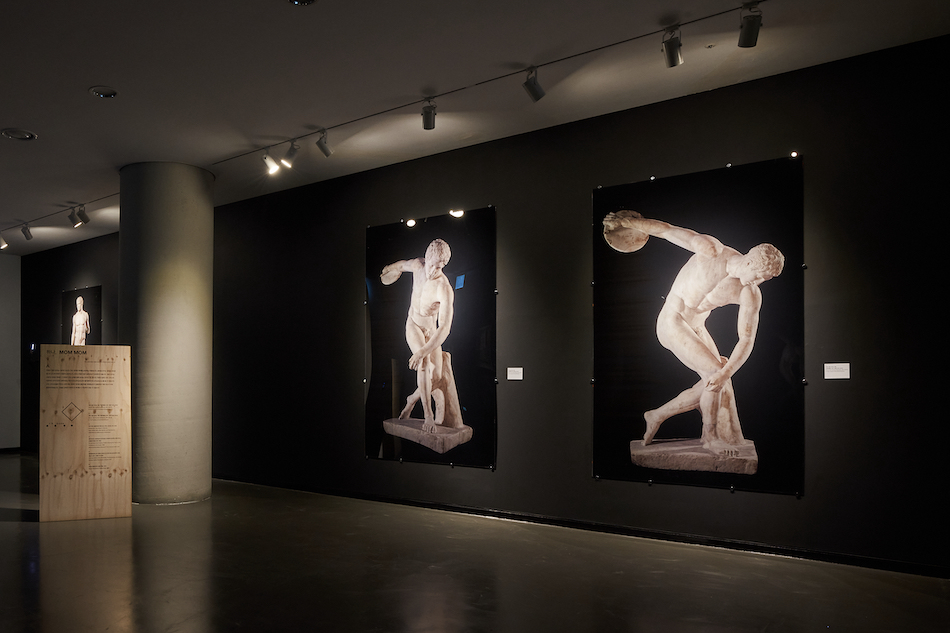
Contemporary artists are meant to shake off the mythologised or ritualised power and violence seen through sports games. Evi Kalogiropoulou’s work takes the Greek mythological figure Medusa into a 21st-century version of a cyborg. Medusa is expressed as a running machine by taking a cue from Donna Haraway, where her cyborg is an emancipatory figure blurring the separation between human and animal and human from machine. Kalogiropoulou’s other work, The Beauty and the Innocent questions the sports industry’s consumption of body and gender images with a provocative performance video.
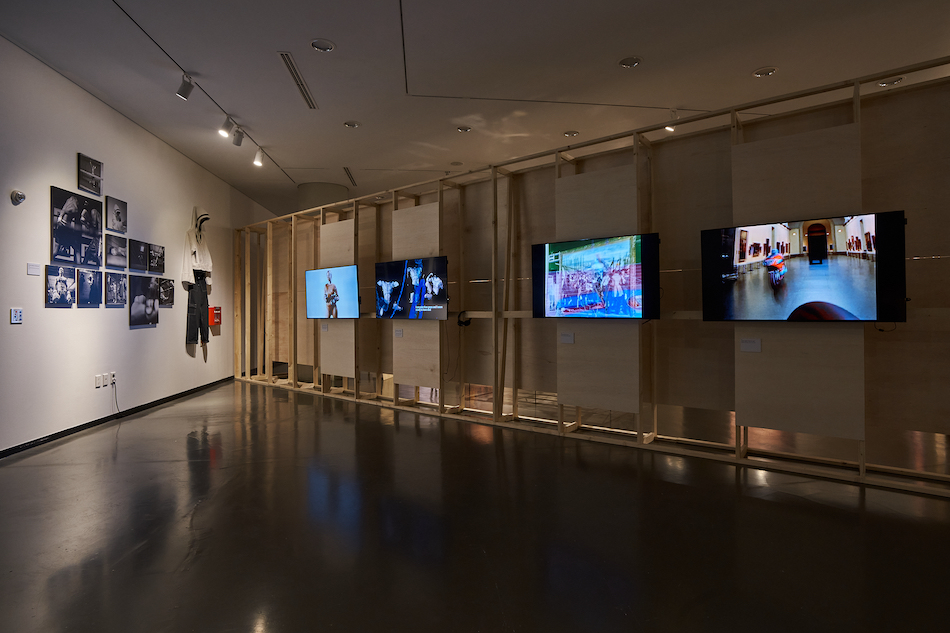
Eugenio Ampudia shows professional athletes ready to jump, revealing the altered painting as their huddle. In his highly evocative work, Prado GP, cyclists pass the old masters and shine a light. The repetitive action of the athletes makes them look similar to soldiers. Cole Hanauer photographs boxers in his designed clothes, challenging the traditional concepts associated with boxing.
Jia Chang challenges taboos by photographing the naked female body urinating in Standing Up Peeing, and the works are chosen concerning Doryphoros, considered the ‘canon’, possessing ideal proportion and beauty. Bee Chee Chang’s Look Inside is the first step of three steps of mind, where the audience is encouraged to look inside the box, to experience as if one were looking through one’s own mind.
The exhibition journeys into a literal marriage between art and sports with Lie Sang Bong’s five dresses for Olympic gold medalist Yuna Kim. Shown with the IOC recording of her Sochi Olympic performance, the dresses are hand-modelled and show how the dress is meant to express her weightless jump and flawless techniques.

The historical archives of the winter Olympics show Korea's long history of winter sports. Korea is naturally mountainous, making skiing a natural method of transport. I compared several historical archives of winter sports with Miguel Nunes’s photo of the European bodyboarding champion, Hugo Pinheiro. High tides are deadly to amateur surfers. This is then juxtaposed with Oh Minsu’s monumental Korean ink painting that includes people enjoying sports within nature in the traditional Korean genre painting style.

The theme of sports and water continues, and how sports were connected to the evolution of class and leisure is highlighted by James Harris’ Blue Lagoon Iceland and George Seurat’s Bathers at Asnières. The former is from the 21st century, while the latter is from the 19th century. Seurat’s iconic painting was reproduced from the National Gallery with its consent and shows workers relaxing in the river Seine and is meant to contain class criticism.
The pairing of old and new is changed to the pairing of East and West: Ji Hyun Yu’s illustration of Chariot was commissioned to refer to how the Olympic sports derived from Greek mythology and how the Olympics derived from serving the gods. Lee Sangyong’s chariot, on the other hand, is at odds with Korean tradition, where people believed chariots were temporary shelters for bodies and souls to rest before reaching the next life.
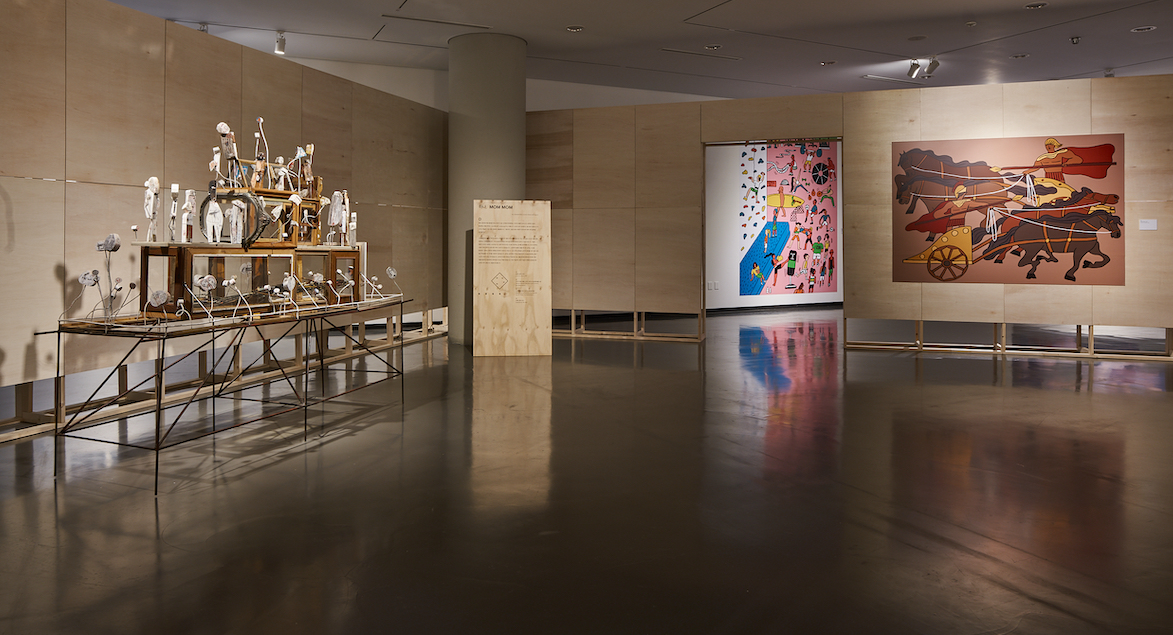
Inside this ‘room’ within a hall are the chariot and tomb paintings from Goguryeo, the ancient Korean Kingdom that stretched far into China and Russia. Hunting using archery was an important event that worked to train the army and had ceremonial usage. A lesser-known tomb painting of Ssireum – traditional Korean wrestling – is also inside, revealing the multicultural society that Goguryeo was.
The second part examines technological advances that will change art and sport forever. Je Baak’s Let’s Swim Together investigates the rhetorical question of what would happen if AI learned to swim. Indeed, AI lacks a body and therefore can’t physically swim. Nonetheless, AI conceives visually how to swim, which leads us to question the world we live in and the relationships between thought, sentience, AI and the purpose of bodies.
Moritz Waldemeyer revisits the core of Martial Arts, a meditational practice, along with a fighting system. We encourage visitors to learn about the ‘art of the sword’, which is different to ‘the way of the sword’ and ‘the skill of the sword’. Visitors can use the swords to record the sword's path using cameras’ long-exposure technology.
Sadeck Waff’s Murmuration choreography looks mechanical and highly controlled, using light as props and the seamlessness of endless rehearsals. Le ballet des lucioles depicts the swarm of fireflies, using lights as props. Regarded as one of the most influential artists of the 20th and 21st centuries, Marina Abramović’s seminal work Rest Energy epitomises performance art that uses the body to the extreme but ironically is amplified by the heartbeats of Marina Abramović and Ulay. While they suspend their bodies in absolute trust for each other, the arrow faces Abramović’s body, with Ulay holding a bow; the temporality of performance art can be translated to the work using recording devices.

The exhibition also provokes questions about how the blockchain industry is driving specific artworks, gamified military actions and human-free news reportage are increasing, and art in augmented reality is exploring new frontiers. Chang Bee Chee’s second work shows light and darkness within a box, entitled Look Back, where the electronic circuits create an illusion of one’s past.
Last Instalment - BRAVO
It argues that humanism and collaboration are the most crucial aspects being considered. Staring with Marina Abramović Institute’s work Cleaning the House workshop. The space encourages visitors to leave their mobile phones and enter quietly, emphasising the importance of training and emptying the mind to create art. Paula Garcia’s RAW shows the collaboration of highly challenging art projects, as various participants help Garcia prepare for a racing car crash. This ‘dangerous’ work needs an important collaborator – the other driver, who is a stunt man. One sees him coming out of the car after a crash too. The viewer understands the work’s context by looking at the Noise Bodywork. Chang Bee Chee’s Look Beyond is at the end of the exhibition.
With this overview, you are now ready to see the exhibit yourself, up close and personal, so that you too can question the meaning of arts and sports from multiple angles. This is especially important due to the pandemic when we experienced the ultimate separation between bodies and ever closer networks. Advanced technology nurtures new mediums for art and challenges the very nature of creating art.
The MOM ∞ MAM show opened on 1st April and will close on 7th August. I hope you will see it and Forever Free at Savina Museum from June 15th to August 21st.
Forever Free
Koh Sang Woo exhibition Forever Free is open until the 24th of August in Seoul’s Savina Museum. The exhibition is co-hosted by the Museum and the WWF (World Wide Fund for Nature). The artworks call attention to endangered animals. With different compositions that are stunning, animals seem to look straight into our souls. What is the message that this artist is conveying? In these blue-toned digital paintings, there is one Leopard with diamond eyes. Not only do leopards get hunted for their skins, but Koh also references how humans ruin the earth to extract diamonds.

The exhibit forces us to consider the future of 20 endangered animals depicted by Koh. These beautifully illustrated animals reveal the intricate and fragile state of our most recognised and beloved animals, from tigers to gorillas to owls.

NIGHT VISION, 2022 KOH SANG WOO Edition of 10 103 x 103 CM 150 x 150 CM | Price upon Request (Currently in London)
 Hibernation (Bear), 103x103 or 150x150 cm, 2019 Koh's process is exhaustive; each work takes a substantial amount of time to complete. From his iconic photographs of carefully selected animal subjects, Koh inverts these into digital paintings, painstakingly altering and highlighting each with a digital brush. Many visitors' initial reaction to the realistic and natural detail, vividly rendered by every one of the digital brush strokes, is the impulse to reach out and touch the canvas. Koh technique breathes air into these endangered animals with his art. It was a powerful moment that drove me to curate an exhibition entitled TOUCH, with Koh's work as the centrepiece. I plan to show more of Koh's work from this series because you cannot replicate the experience of seeing it in person.
Hibernation (Bear), 103x103 or 150x150 cm, 2019 Koh's process is exhaustive; each work takes a substantial amount of time to complete. From his iconic photographs of carefully selected animal subjects, Koh inverts these into digital paintings, painstakingly altering and highlighting each with a digital brush. Many visitors' initial reaction to the realistic and natural detail, vividly rendered by every one of the digital brush strokes, is the impulse to reach out and touch the canvas. Koh technique breathes air into these endangered animals with his art. It was a powerful moment that drove me to curate an exhibition entitled TOUCH, with Koh's work as the centrepiece. I plan to show more of Koh's work from this series because you cannot replicate the experience of seeing it in person.  Shangri-la, 120 x 120 cm, TOUCH exhibition, London 2021
Shangri-la, 120 x 120 cm, TOUCH exhibition, London 2021  Fate | TOUCH exhibition in 2021, London by ISKAIART www.iskaiart.com Koh has had a meteoric rise in the art world. Even before graduating from the Chicago Art Institute in 2001, he became the first Asian man to sign a contract with Carl Hammer Gallery. His works have always been provocative and included a series of self-portraits of him disguised as a white woman and photographs of women weighing more than 100 kgs. Koh exhibited at the Armory show in New York in the 2000s, and many notable collectors, from Madonna to Ray Dalio, acquired his works.
Fate | TOUCH exhibition in 2021, London by ISKAIART www.iskaiart.com Koh has had a meteoric rise in the art world. Even before graduating from the Chicago Art Institute in 2001, he became the first Asian man to sign a contract with Carl Hammer Gallery. His works have always been provocative and included a series of self-portraits of him disguised as a white woman and photographs of women weighing more than 100 kgs. Koh exhibited at the Armory show in New York in the 2000s, and many notable collectors, from Madonna to Ray Dalio, acquired his works. 
Koh's work has also been recognised in social and political spheres. Fate, depicting the last tiger of the Joseon Dynasty (Korea's ancient kingdom), was used as the background for President Moon Jae-in's New Year's greetings at the Blue House in January of 2022. His work is prolific and increasingly popular, thriving with the boom of the Korean Art scene and the opening of the Frieze Exhibition in Seoul in 2022.
Collectors have found Koh’s work an attractive investment from a financial perspective. Prices have steadily climbed, with old works seeing significant appreciation. This new collection has met with robust sales and strong pricing. Koh’s Pierrot Lion, for example, realised 21,250 GBP in 2020, 2 years before his work was shown at the Blue House.
***
Giardini and Arsenale In The 59th Venice Biennale
No matter how many times you’ve been to Venice, still, you marvel at how enchantingly beautiful Venice is. After the lockdown, the view was even more precious.
This biennale was always going to be a bit different. The 59th Venice Biennale, an international contemporary art exhibition held between April and November 2022, meant the first mass gathering of the art world in well over two years.
But with the Russian Invasion of Ukraine, the biennale finds itself overcast by war’s long shadow. When I arrived in Venice, the first show I walked into was a small shop-sized exhibition by a Ukraine artist.

It had a table with loaves of bread but was made of stone.
Zhanna Kadyrova, the artist, calls the work Palianytsia, which is bread - usually a staple of the Ukrainian diet. She did these works after she fled with her family from her home town Kyiv to a temporary shelter.

The Scuola Grande della Misericordia is hosting the exhibition This is Ukraine: Defending Freedom until 7 August Photo: Pat Verbruggen
However, despite the grim prospect, one cannot hide the joy of seeing friends you haven't seen for three years. Everywhere, people were being reunited.
The following day, I woke up early to get to the Arsenale an hour earlier to beat the queue. I found Anda Winters, the Director of Coronet Theatre in Notting Hill, who had the same thought as me. She is about to launch a tremendous Korean Festival At Coronet theatre end of August. You will see the theatre wrapped up in colours; it is the work by Choi Jeong Hwa. I worked with Choi a lot, and he is a marvellous artist.
Back to Venice. (This is the thing. Everywhere you go in Biennale, you will find someone so engaging. If you are looking at works of art in the Biennale, strike a conversation with the person next to you!)
Expect to see a cacophony of colours and surreal paintings. Corresponding to the overall theme, Milk of Dreams, the Biennale as a whole is a fantastical post-humanist world of dreams with some optimism but mixed with dystopian. The Biennale is divided into two venues: Arsenale and Giardini. Both spaces are walkable distances from each other. Giardini drives from it being a garden, and it has separate national pavilions, including the GB, France, Russia, France, Japan, Korea, the USA, and so on. Arsenale, a complex of former shipyards and armouries, houses many pavilions, including Oman, Ghana, Italia, etc. Each year, both places have a 'central pavilion' curated by the artistic director. This year is Cecilia Alemani.

Most striking and talked about was the Maltese Pavilion. Entering it may feel like moments of a biblical firestorm as drips of actual molten steel drop down into seven square water tanks. You nod after reading how it represents the figures in Caravaggio’s The Beheading of St John the Baptist.

Italian Pavilion, Arsenale, History of Night and Destiny of Comets, Gian Maria Tosatti
Italian pavilion asks, 'What is the future for humans?' It is at the far end of Arsenale, but I went there first as I was curious to find out how it looked, the first pavilion given to a single artist Gian Maria Tosatti. It usually features multiple artists simply because it has a vast space - 2000 sq metres.
In a series of rooms, viewers walk into a nearly too realistic reconstruction of warehouses, forming an immersive exploration of industrial Italy's rise and fall. It may be a metaphor for human relations with our surroundings. Froom warehouses littered with tools, disused machinery, swimming machines, watchtower and tables, viewers enter darker spaces and eventually arrive at what looked like rusty spaces lit with LEDs imitating natural light.

Ayman Baalbaki's Janus Gate, Lebanese Pavilion. Arsenale

Icelandic Pavilion, Arsenale Sigurður Guðjónsson curated by Monica Bello
Ayman Baalbaki’s Janus Gate reinforces the idea of a fragmented city. One side is covered in alluring neon lights and spray-painted tarpaulins while a disconcerting hut filled with detritus sits behind the tawdry façade, illustrating the “two faces” of Beirut.
Reykjavík based contemporary artist Sigurður Guðjónsson is the star of the Icelandic Pavilion. Its multisensory sculpture is called Perpetual Motion. The artwork offers a poetic exploration of materiality at the edge of the boundaries of perception. The Icelandic Pavillion is curated by Mónica Bello, head of arts at Cern. (Cern is short for European Organization for Nuclear Research. It is one of the world's largest and most respected scientific research centres, and I invited her as an advisor for one of my exhibitions in 2016). The artist filmed metal dust scattering and gathering around a magnet. Thus, the work is turned into mesmerising imagery of the metal fragments' altered speed, colour, and direction. The soundscape also accompanies the finished imagery, and it is the amplified immersive projection that is magnetic and interplanetary.
You will see various voices from nations. Some you do not have to look at the caption, such as New Zealand Pavilion Paradise Camp by Yuki Kihara.
My favourite room of the Arsenale was the striking room of the central exhibition by Precious Okoyomon. It is entitled To See the Earth Before the End of the World (2022). Viewers enter the constructed landscape of living plants like kudzu and sugar cane, dotted with figural sculptures made of wool, yarn, and mud that seem to sprout up from the earth itself.

Precious Okoyomon, Earth Before the End of the World (2022). Photo by Ben Davis.

I loved The Parents' Room by Diego Marcon. It is masterfully shot on 35mm film and soundtracked by an original musical score composed by Federico Chiari and recorded at London's Trinity School of Music. It is a mix of musical cinema, a bit of horror, slapstick comedy, musicals, and cartoons.

Simone Leigh who represented USA Pavilion also welcomes guests at the Arsenale
You will not miss Simone Leigh's sculpture in Arsenale. First to be seen in Venice, one might be familiar with her work as seen before in the New York's High Line. In New York, Brick House is was 16-foot tall bronze bust of a black woman. It represents a strong Black woman who stands with strength, endurance, and integrity, like a house constructed of bricks. This year, she also represents the USA pavilion, the first Black woman artist to represent the country. She won the Golden Lion, the most prestigious award of the Biennale this year.
If you have seen the Arsenale, you should move to Giardini, where 29 pavilions of foreign countries exist with the central pavilion. If it is your first time, maybe head to Giardini first, as each pavilion’s personality is more apparent.
I have known the Artist Kim Yunchul, who represents the Korean pavilion but seeing him again in Venice was extraordinary. I was amazed to see the Korean Pavilion transformed with five large-scale kinetic sculptures and a site-specific wall drawing. Gyre is the title, and the pavilion is its living world own. There are The Swollen Suns, The Path of Gods and The Great Outdoors.
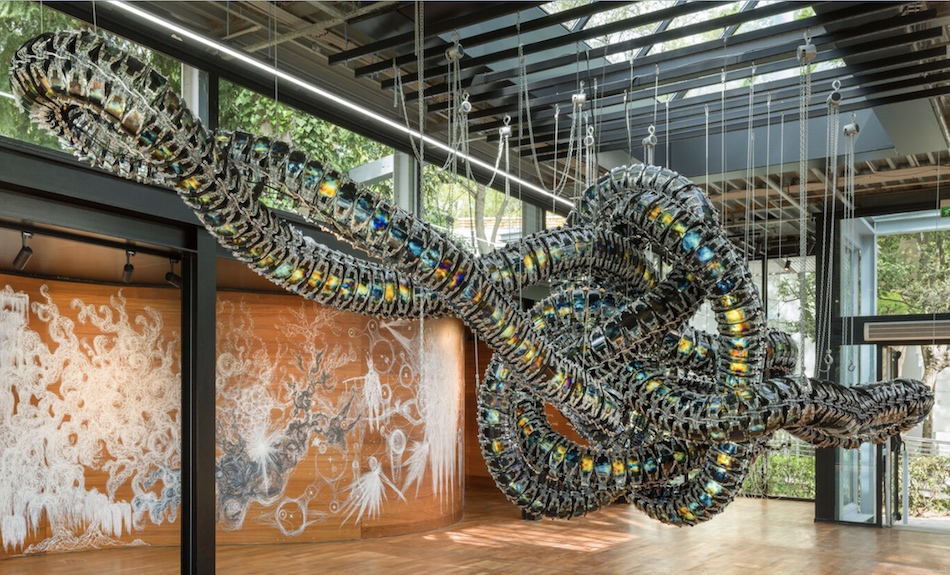
Yunchul Kim, Chroma V, Gyre, 2022
Another favourite of many people was the French Pavillion. Zineb Sedira is a French Algerian artist. And in this pavilion, you first see a 1960s style bar. The entire pavilion has been arranged like a series of studio interiors in a film shoot. Screening in a room behind the bar is based on the first film made in newly independent Algeria in 1964, Les Mains Libres (the free hands); this year represents the 60th anniversary when Algeria became independent from France.
I hope I have not bombarded you with too much information. Here are some of my favourites from the Venice Biennale. I have only covered Giardini and Arsenale, but please explore collateral and museum exhibitions. The Biennale is open till the end of November this year, as many of the exhibitions would be.
Photo credits: Iskai Art
***
New York Art Week
Many familiar faces will reunite in New York this month as more than 20 New York-based art organisations have come together to launch the first “New York Art Week”. This week not only sees four art fairs —Independent, TEFAF New York, NADA New York, and the Future Fair —opening simultaneously but also a fully curated series of exhibitions and events in museums will take place throughout the city. It has been said that New York has seen nothing like this. The closest comparison will be London in its Frieze Week, when London transforms into a giant web of collateral and satellite art events.
Auction houses join the forces too. Christie’s, Sotheby’s and Phillips, undoubtedly the top three auction houses, will participate in the first New York Art Week, adorning each place with the best lots. Phillips, for instance, will auction off Jean-Michel Basquiat’s painting Untitled Devil, estimated to be worth $70 million. But, of course, museums across the city are also the main attractions. Here are some favourite picks.

Jean-Michel Basquiat | Untitled
Signed, inscribed and dated "JEAN MICHEL BASQUIAT MODENA 1982." on the reverse acrylic and spray paint on canvas 94 1/4 x 197 1/4 in. (239.4 x 501 cm)
Executed in 1982 | Estimate in the region of $70 million
NADA stands for New Art Dealers Alliance. The 8th edition of NADA New York will be returning to the Lower East Side from May 5 - 8. At Pier 36. NADA New York will showcase a diverse selection of 120 galleries, art spaces, and non-profit organisations spanning 37 cities and 18 countries, including Buenos Aires, Mexico City, Paris, and Tokyo.

TEFAF stands for ‘The European Fine Art Fair The European Fine Art Fair’, organised by the European Fine Art Foundation in Maastricht, Netherlands. ; New York City provided the ideal setting for a TEFAF fair outside of Maastricht. 2022 will be the eighth edition of TEFAF New York at the historic Park Avenue Armory on May 6–10, 2022.
Independent Art Fair takes place at Spring Studio, 6-8 May. Independent started in 2009 at the former Dia Center for the Arts and the former home of X Initiative at 548 West 22nd Street (this year, the same venue hosts The Future Fair). Independent relocated the New York edition of the fair from Chelsea to Spring Studios in Tribeca in 2016. It joins the Tribeca Film Festival ecosystem as one of two public events annually in this location.
The Future Fair, the second in-person edition of the exhibition, will occur at Chelsea Industrial, located in the gallery district at 535 W 28th Street.
There are dozens of museums across the city that participate in the week. This includes the Metropolitan Museum of Art, the Studio Museum in Harlem, the Museum of Modern Art, the Whitney Museum, the Guggenheim Museum, the Queens Museum, and the Brooklyn Museum.

Here are three recommendations. On the 12th, the Gala at the Queens Museum will celebrate the 50th anniversary of the museum, and one can join the force by having a table or buy an individual premium ticket (cost from 700dollars to 25,000dollars for a premium table of ten). This year will be honouring artist Christine Sun Kim whose large scale mural Time Owes Me Rest Again addresses the theme of repetition and time. The evening will include a lively cocktail party with hors d’oeuvres provided by local restaurants, a delicious dinner by Abigail Kirsch, special performances, and a paddle raise to support the Queens Museum’s impactful programs.

My second personal choice will be Whitney Museum to see the legendary Whitney biennial. Surveying the landscape of American art and shaping the cultural conversation since 1932, the eightieth edition of the landmark Whitney Biennial is available. Again, you can choose between two different perspectives: one is designed like a labyrinth, the other like an open field.
If you want to see the legendary art sale, join the 20th Century & Contemporary Art Evening Sale Auction on 18 May 2022. There are not many seats available, so book your pace in advance. The Basquiat is at lot number 12. The viewing is already opened from Monday to Saturday (10:00am-6:00pm) and Sunday 12:00pm-6:00pm.

If you have time, browse through the internet in advance of what museums across the city offer special exhibitions. Whether it is the Metropolitan Museum of Art or the Brooklyn Museum, it will provide detailed press releases beforehand so that you can plan. In addition, I recommend checking out Amant, the artist residency and exhibition space established in Brooklyn by Lonti Ebers, to see how one of the best collectors of time has curated his museum shows.
Much is happening, plus the weather and the revived energy and optimism of New York are felt even in the air.
***
La Biennale Di Venezia
The Biennale is back!
What to expect and what to look for as the 'Olympics of art' returns in 2022?
If you want to see the biggest and most glamorous congregation of the world's art crowd since the pandemic, come to Venice this April.

A little background…
Biennale means every other year and is held in Venice. Venice Biennale is the most important art exhibition in history. At first, it was held to mark the silver anniversary of the accession of King Umberto I of Italy and his consort, Margherita of Savoy.
From 1907, national pavilions appeared, and except for a few interruptions, the Biennale has been held in odd years. The traditional site of the national pavilions in the Giardini ran out of space over the years and as a result, countries began to stage shows in the Arsenale and venues across the city.
Along with the national pavilions, there is a central exhibition in the Central Pavilion and official collateral events across Venice. Overall, it is a breath-taking feast of art that even the biggest art glutton would struggle to consume.
This year feels particularly significant as the pandemic marked the event's first postponement since WWII. The Biennale embodies the international spirit, which feels particularly important with the tragedy unfolding in Ukraine. The Russian pavilion's curator and artists withdrew from the Biennale this year, making the Pavillion empty, and Biennale stated they would support Ukraine as much as possible.
It will also be the first time since the pandemic that the leading lights of the art world can truly congregate, and artists, curators, gallerists, and collectors will come to Venice to understand the contemporary art of 'today'.
This year, the 59th International Art Exhibition will take place from 23 April to 27 November 2022. And the real action will take place during the previews on 20, 21 and 22 April. It is in the preview week that the ultra-glamorous parties and dinners take place.

During the preview week, parties start early - normally from Monday, which means you will witness small Venetian boats not accepting hop-in guests but dedicated to groups of partygoers. Some Gondoliers and events share long histories, and the magic of boats of partygoers arriving with flickering torches, docking right inside the palazzo, never grows old.
(Beautiful Palazzo, aka The Museo Fortuny, is an art museum in San Marco, in central Venice, Italy. They host the most beautiful art exhibitions during the Biennale)
The Biennale epitomises the whirling world of art, money and beauty that makes you marvel but can be grotesque at the same time. You come back because the attraction is not just art and parties. There are hidden frescoes, trattorias full of interesting personalities, and historical corners that have enchanted many artists throughout history and conjured memories.
I have always stayed at the Metropole offseason. Prices escalate during the preview week, and rooms in the best hotels can be very hard to come by, even booking well in advance. The Metropole is my favourite, it overlooks the lagoon, and the view over San Giorgio Island is drop-dead gorgeous. Death in Venice was claimed to be written because Thomas Mann stayed there.

I was curating a parallel exhibition at the 2015 Biennale inspired by the novel and Mark Wallinger's Artwork called Sleeper - hence the title Sleepers in Venice. While I stayed there, I learned more about the hotel's history - all 67 rooms are different, with a mix of 18th-century antique and art deco furniture. The rich Fortuny fabrics and red velvets make it well worth a visit.
Two other hotels that also are world-famous are Danielli and Cipriani. Look for Hotel Danieli with Byzantine Gothic style arches (first opened as Palazzo Dandolo at the end of the 14th century) and Cipriani, the birthplace of Bellini, the cocktail!

Back to art…
Each Venice Biennale edition selects an Artistic director who will curate the Central art exhibition. Cecilia Alemani will curate this year, the first Italian woman to hold this position. She has spoken about how she would like to give voice to artists to create unique projects that reflect their visions and our society. The exhibition topic – The Milk of Dreams, was born in the depth of the pandemic and seeks to be optimistic and shake off a nightmarish few years.
Named after a relatively unknown book by Leonora Carrington (1917-2011), the Milk of Dreams has writings and drawings where the surrealist artists describe a magical world where life is constantly re-envisioned through the prism of the imagination. It is a world where everyone can change, be transformed, become something or someone else.

The dark side to the story is how she was also locked up in mental hospitals as if to allude to our century of destruction. However, there is also a strong connection with AI challenging artmaking. We saw each other only behind the screens of electronic devices during the pandemic - Carrington said she was born through her mother's encounter with a machine.
The exhibition takes Carrington's otherworldly creatures and other figures of transformation as companions on an imaginary journey through the metamorphoses of bodies and definitions of the human. A symbolic web of beauty, species, and so far, under-represented artists.
Expect to see more than two hundred artists from 58 countries and strong representation from women and gender non-conforming artists.
The world the exhibition presents will be the opposite of the presumed universal ideal of the white, male "Man of Reason" − as the fixed centre of the universe and measure of all things.
When in doubt in Venice, always find Scuola Grande di San Rocco - the Doge'sPlace to see Tintoretto.
***
See more of Dr. Stephanie Kim work iskaiart.com & Instagram @stephanie_s_kim



